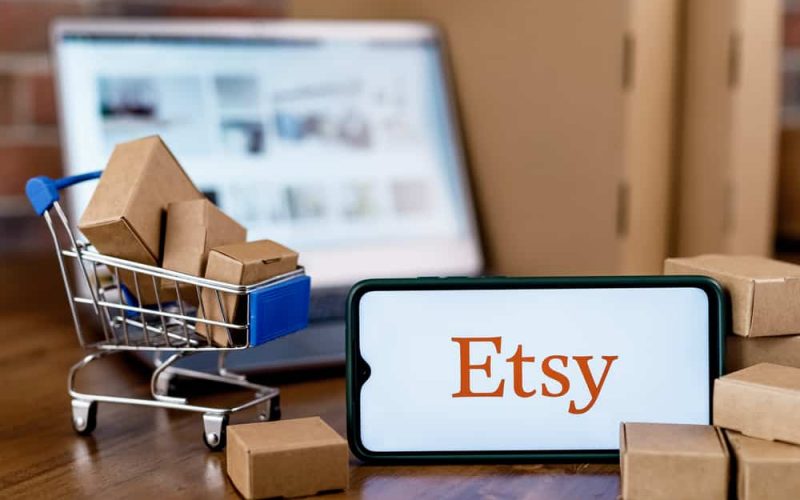Starting a new business on Etsy for beginners can be daunting. Discover how to make the process more manageable (and enjoyable!) by following a few easy guidelines. Starting your first online business can feel like your first vacation in a strange country, with new concepts, tactics, and terminology to learn. To prepare for your first few months of selling on Etsy, it can be beneficial to plan ahead of time and get an idea of how things work before you get started. If you’re new to selling online or want to learn how to start an Etsy business for dummies, these steps can help.
How to Start an Etsy Business for Dummies
Starting an Etsy business for dummies is an all-in-one resource for launching your profitable business. Arts and crafts are currently a $32 billion business in the United States, and Etsy is the best place to get a piece of it. Thanks to Pinterest, Instagram, and other social media platforms, sales on the site are increasing, so there’s never been a better moment to join the fray. This book will teach you everything you need to know to get started, get things going, and create your business the way you want. You’ll find everything here, from pictures and sales copy to SEO and webpage navigation.
This updated third edition covers Etsy’s newest seller features, such as Pattern, Etsy Manufacturing, Etsy Shop Updates, and the Dashboard. It also has expert advice on QuickBooks Self-Employed to help you keep your business’s finances in order. This book is your comprehensive guide on how to start an Etsy business for dummies, with helpful information, ideas, tools, and tactics.
- Use beautiful images and intriguing listings to highlight your products to their most significant potential.
- Understand the technical aspects of opening a shop and processing orders.
- Use the most recent Etsy tools and features to manage your storefront efficiently.
- Boost sales by networking with other retailers and marketing on Pinterest.
Do you consider yourself an artist, crafter, artisan, or craftsman? Etsy might be an additional source of income. Are you simply interested in whether your projects will sell? To test the waters, wade in slowly. Start an Etsy Business For Dummies tells you how to stake your claim on Etsy, home to enterprises of all sizes and types.
How to Start an Etsy Business for Dummies
Consider selling your work on Etsy if you want to turn your passion for creating and artistic creativity into a business. Many crafters have quit their day jobs to start an Etsy business for beginners or increase their income by selling their crafts, vintage items, or crafting materials. If you want to “make a living making things,” Etsy is the place to be! Here are some pointers on how to start an Etsy business for beginners:
#1. Creating a visually appealing Etsy storefront
You may customize your Etsy business in a variety of ways. This customization is essential if you want your Etsy store to stand out and help promote your brand. In any case, it’s entertaining!
- Include a cover photo. A cover photo is a graphic that appears across the top of your shop’s main page. You can make your cover photo using any number of graphics applications.
- Include a shop title and a notice about the shop. Consider your shop’s name to be a type of tagline. It succinctly summarizes what your shop is all about. On the other hand, your store announcement promotes what you sell, the materials or components you employ, or your artistic philosophy. Your store announcement could also include the date and time of your next deal.
- Fill up the About part of your shop. Sharing your shop’s story in the About section increases buyer interest in you and your shop.
- Organize your goods using sections. If you sell a variety of things, such as magnets, notebooks, and picture frames, you can organize your shop by item using sections. Even if you don’t sell a variety of items—perhaps you only sell knitting caps—you may utilize sections to organize your products by, for example, yarn type, size, or price.
- Select a strong shop icon. The image that identifies your store on Etsy is your shop icon. Choose a store icon that represents you and your business effectively.
#2. Pricing your work on how to start an Esty business for dummies
Running a lucrative Etsy for Dummies start-up business requires you to know a little math, especially when pricing your goods. Setting a price for your Etsy products may be difficult, but don’t worry! You’re not dealing with calculus or trigonometry here. All you need are two simple formulas to price items for your Etsy business:
- Wholesale Price = (Materials + Labor + Overhead) × 2
- Retail Price = Wholesale Price × 2
When calculating the expenses of your resources, you should only consider the price of what you used to make one piece, not everything you purchased. Labor costs are calculated by multiplying your hourly rate by the time it takes to complete one piece. Overhead expenditures include everything you need to run your business, such as tools and office supplies (but not shipping costs).
It’s worth noting that in the second calculation, you multiply the wholesale price by two to get the retail price. Some dealers may use a higher amount, calculating the retail price by multiplying the wholesale price by 2.5 or even 3 (assuming that the market will bear that). The multiplier you select is entirely up to you.
#3. Creating product photos for your Etsy business
Great product images on how to start an Etsy business for dummies can enhance sales, but you don’t have to pay a professional photographer (though you can if you want to). It’s simple to create your own Etsy photographs. Keep the following compositional considerations in mind when you photograph your pieces:
- Rotate the camera. The subject is slightly off-center when the camera angles or tilts, creating movement and flow. As a result, the image is more vibrant and fascinating.
- Take tight shots. Filling the frame with your subject adds visual impact while also allowing potential purchasers to see how well-made your item is.
- Soften the background. You can blur the background and highlight your work by utilizing a narrow depth of focus (read: a low f-stop setting on your camera). You can shoot in nearly any location when the background is blurred; make sure the background colors don’t clash with your subject.
- Remember that little is more. Outrageous things should be avoided in the scene. Otherwise, potential buyers might be confused about which item in your photo is for sale.
- Define your subject. To bring the viewer’s attention to your piece, frame it – insert a darker material around the perimeter. This strategy keeps the viewer’s attention focused on your item.
- Assemble the components. You can try clustering your itsy-bitsy treats to capture a buyer’s eye, especially if you make them.
- Follow the rule of thirds. Divide the scene into nine equal portions using two horizontal and two vertical lines (similar to a tic-tac-toe grid); position crucial items at one of the four spots where the vertical and horizontal lines meet.
3 Tips for Writing Effective Etsy Listing Titles
Your Etsy listing title functions as a good headline. It’s intended to pique a buyer’s interest. It is also taken into account by Etsy’s search algorithm. That means the headline of your listing has to do two things: catch a buyer’s eye and be search engine optimized. When coming up with listing names while trying to start an Etsy business for dummies, keep these three things in mind:
- Keep it brief. Your item title should be concise (no more than 140 characters) (including spaces).
- At the beginning of the item title, clearly describe your item. This increases the likelihood that others will find your item when searching on Etsy.
- Make use of both upper- and lower-case letters. Too many all-caps words give the impression that you’re shouting. Too many lowercase words, and it appears that you’re attempting to emulate.
Marketing your Etsy business for Dummies
Etsy understands the value of marketing your business, which is why it includes several built-in promotional options. Marketing on Etsy is simple when you use the following tools:
- Promote your Etsy listings. You may use Etsy Promoted Listings to boost the visibility of your listings in Etsy search results when prospective buyers input specified keywords.
- Increase the visibility of your listings on Google. Google Shopping allows you to access buyers who are not on Etsy. Visitors who input particular search terms into Google’s search engine move your listing to the top of the page (or close to it).
- Develop promo codes for your store. Coupons boost sales, raise brand knowledge and awareness, reward current consumers, and attract former customers to return.
- Provide shop updates. Use store updates to show off a new item, advertise an impending sale, or share a lovely picture of your dog in your studio. This helps to securely implant your shop in the “shoppocampus” section of your buyer’s brain.
- Use social media to promote your shop. Sharing your Etsy items on social media with friends, family, and followers is a terrific way to keep people buying from you.
How much does it cost to start an Etsy business?
It costs nothing to start an Etsy storefront, $20 to list a good for four months or until it sells, and 6.5% as a transaction charge. Additional fees and currency translation fees apply to international sales. Fees for payment processing vary.
Is it worth it to sell on Etsy?
Selling on Etsy is worthwhile in 2023 because it is one of the quickest, cheapest, and most straightforward ways to get your handcrafted things online and linked to a shopping cart function. When compared to establishing a website, it is also a low-risk choice.
Is an Etsy business profitable?
Selling on Etsy might be beneficial if you sell a product with large profit margins. When selling on Etsy, you need to consider several costs that will cut your profits or even make you lose money.
How do Beginners sell on Etsy?
Simple steps to start selling on Etsy:
- Register for a free account.
- Open your shop and configure your settings.
- Stock your shop with the merchandise.
- Determine how you wish to be compensated.
- Select your shipping options.
- Set up customer billing.
- Link your shop to your online store.
- Make your Etsy storefront unique.
Why do people stop selling on Etsy?
One of the most common complaints sellers have about Etsy is the number of fees they must pay to sell on the platform. There is a listing fee, a transaction fee, and a payment processing fee for each item.
How do Etsy sellers get paid?
Your payment will be deposited into your Etsy payment account or PayPal account or mailed to the address you have on file, depending on the payment options you offer in your shop.
Is there a monthly fee for Etsy?
An Etsy Plus subscription costs USD 10 each month. The monthly fees for Etsy Plus are taken out of your balance and shown in your payment account. Etsy may add local taxes (like sales taxes, VAT, or VAT/GST) to your monthly subscription price if they apply.
What is the best product to sell on Etsy?
Etsy’s best-selling items:
- Sticker. The first trending product on Etsy is stickers.
- A notebook and journal
- Jewelry.
- Home decor.
- Digital designs or graphic designs
- Posters.
- Toys and baby items
- Vintage items.
How much does the average person make on Etsy?
The typical successful Etsy seller earns between $43,000 and $46,000 per year, a great base to expand on, given that top earners make over $65,000 each month!
Conclusion
Because of the platform’s user-friendly layout and quantity of internal resources, learning how to start an Etsy business for dummies is logistically straightforward. The actual labor, however, begins once you open an Etsy shop.
As a result, don’t be disheartened if your store opens to little (or no) traffic. It can take time for your Etsy shop to gain a following, just like it does for new brick-and-mortar establishments.
And once you’ve made your first transaction, keep the conversation going with your customers. Check your inbox for messages often, answer questions quickly, help people with problems, and ask for feedback.
Related Articles
- BEST ETSY BLACK FRIDAY SALES IN 2023
- HOW DOES ETSY MAKE MONEY? The Unique Business Model
- Accounting For Dummies: Best Easy Guide (+ free pdf)
- ETSY AFFILIATE: Reviews and Guide
- 51+ ETSY SHOP IDEAS To Consider In 2023






